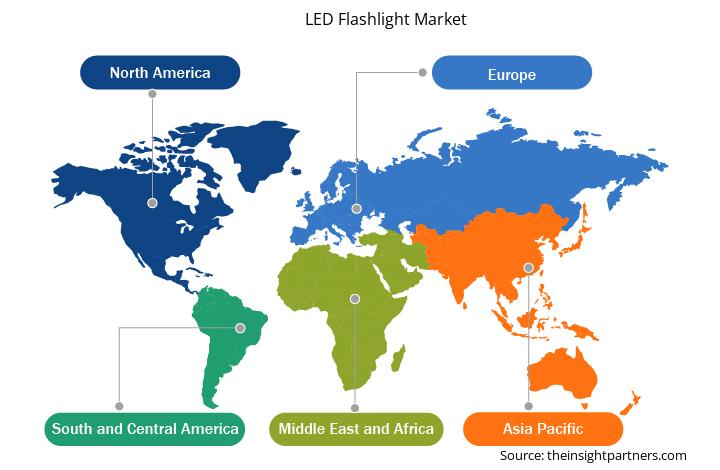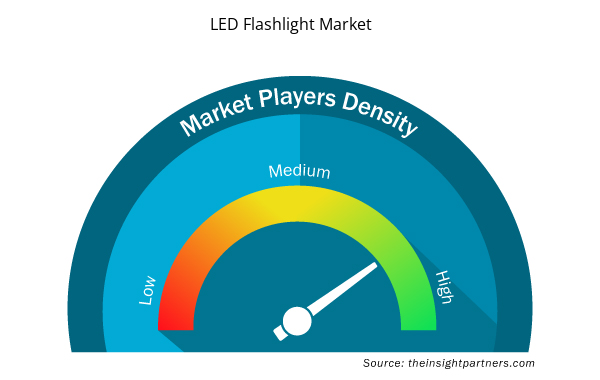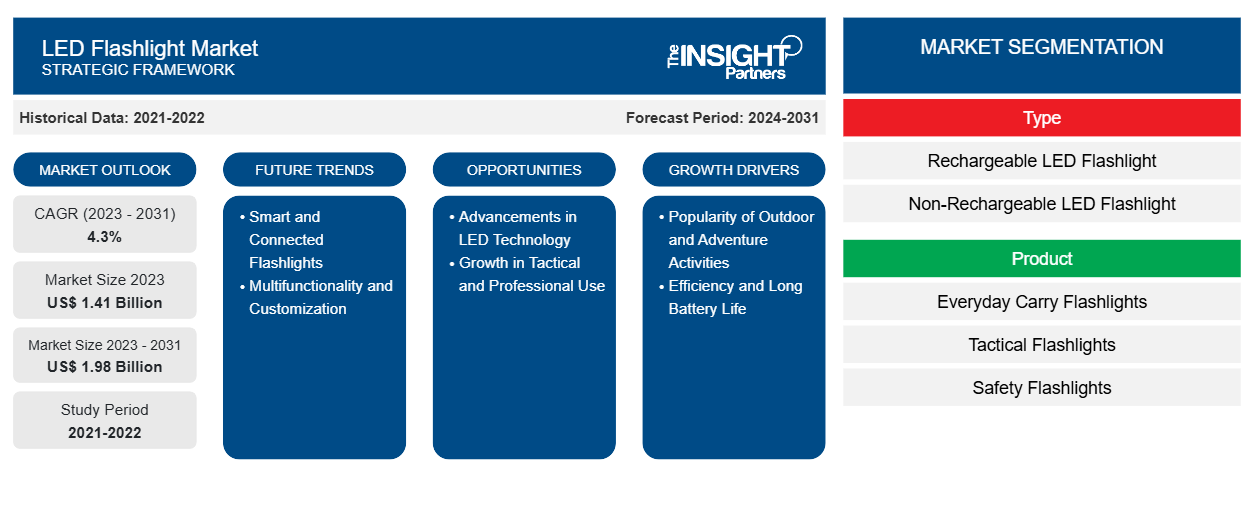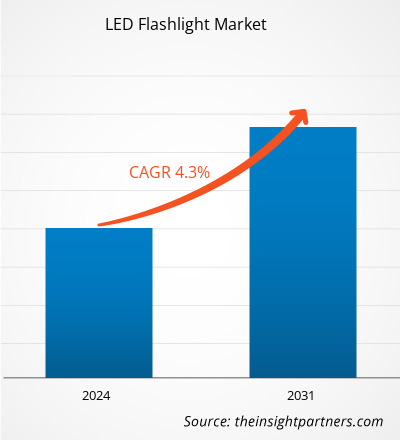Der Markt für LED-Taschenlampen soll von 1,41 Milliarden US-Dollar im Jahr 2023 auf 1,98 Milliarden US-Dollar im Jahr 2031 anwachsen. Der Markt wird zwischen 2023 und 2031 voraussichtlich eine durchschnittliche jährliche Wachstumsrate (CAGR) von 4,3 % verzeichnen. Die steigende Nachfrage nach intelligenten und vernetzten Taschenlampen dürfte in den kommenden Jahren neue Trends auf dem Markt mit sich bringen.
LED-Taschenlampen Marktanalyse
Die wachsende Beliebtheit von Outdoor- und Abenteueraktivitäten sowie die Effizienz und lange Batterielebensdauer von LED-Taschenlampen treiben das Wachstum des LED-Taschenlampenmarktes voran . Da immer mehr Menschen an Outdoor-Aktivitäten wie Camping, Wandern und Jagen teilnehmen, besteht ein wachsender Bedarf an zuverlässiger, tragbarer Beleuchtung. Darüber hinaus sind LED-Taschenlampen sehr energieeffizient, verbrauchen weniger Strom und haben eine längere Batterielebensdauer als herkömmliche Glühlampen oder Halogenlampen. Darüber hinaus dürften Fortschritte in der LED-Technologie und das Wachstum im taktischen und professionellen Einsatz lukrative Möglichkeiten für das Wachstum des LED-Taschenlampenmarktes schaffen. Intelligente und vernetzte Taschenlampen sowie Multifunktionalität und Anpassungsfähigkeit von LED-Taschenlampen dürften neue Trends auf dem LED-Taschenlampenmarkt mit sich bringen.
LED-Taschenlampen Marktübersicht
LED-Taschenlampen sind technologisch fortschrittlich und können weit mehr als nur grundlegende Haushaltsanforderungen erfüllen. Sie sind heller, effizienter und zuverlässiger als herkömmliche Taschenlampen. LED-Taschenlampen werden für eine Vielzahl von Zwecken eingesetzt, darunter Notfallszenarien, Outdoor-Aktivitäten wie Camping und Wandern, Militär- und Polizeieinsätze, Industrieinspektionen und den persönlichen Alltagsgebrauch. Sie sind für die Sicherheit zu Hause, die Autowartung, Fotografie, medizinische Untersuchungen und wissenschaftliche Forschung von entscheidender Bedeutung. Ihre hohe Energieeffizienz, Langlebigkeit und ihr intensives, fokussiertes Licht machen sie für eine Vielzahl von Anwendungen unverzichtbar. Der Markt für LED-Taschenlampen profitiert auch von der Umstellung auf nachhaltige Produkte, da LED-Taschenlampen energieeffizienter sind und länger halten als herkömmliche Glühlampen oder Leuchtstofflampen .
Passen Sie diesen Bericht Ihren Anforderungen an
Sie erhalten kostenlos individuelle Anpassungen an jedem Bericht, einschließlich Teilen dieses Berichts oder einer Analyse auf Länderebene, eines Excel-Datenpakets sowie tolle Angebote und Rabatte für Start-ups und Universitäten.
- Holen Sie sich die wichtigsten Markttrends aus diesem Bericht.Dieses KOSTENLOSE Beispiel umfasst eine Datenanalyse von Markttrends bis hin zu Schätzungen und Prognosen.
Treiber und Chancen auf dem LED-Taschenlampenmarkt
Effizienz und lange Akkulaufzeit
LED-Taschenlampen sind sehr energieeffizient; sie verbrauchen weniger Strom und haben eine längere Batterielebensdauer als herkömmliche Glühlampen oder Halogenlampen. LED-Taschenlampen verbrauchen weniger Strom, um dasselbe oder sogar mehr Licht zu erzeugen, was sie zu einer bevorzugten Wahl für Taschenlampen macht. Dies ist besonders wichtig für Benutzer, die auf Taschenlampen für Outdoor-Aktivitäten, Notfälle oder den professionellen Einsatz angewiesen sind, bei denen die Maximierung der Batterielebensdauer von entscheidender Bedeutung ist. LED-Taschenlampen werden immer beliebter, da Verbraucher und Unternehmen aufgrund ihrer geringeren Betriebskosten und geringeren Umweltbelastung Wert auf Nachhaltigkeit und kostengünstige Lösungen legen. Verschiedene Anbieter auf der ganzen Welt bieten LED-Taschenlampen an, die effizient sind und eine lange Batterielebensdauer bieten. Beispielsweise bietet Anker’s Community Anker’s Bolder LC90 an, eine hocheffiziente, kostengünstige LED-Taschenlampe für den alltäglichen Gebrauch. Sie hat eine Batterielebensdauer von bis zu 6 Stunden bei hoher Helligkeit (900 Lumen) und kann über USB-C aufgeladen werden, was für aktuelle Benutzer eine praktische Funktion ist. Darüber hinaus ist die Fenix PD36R eine wiederaufladbare LED-Taschenlampe, die bei Outdoor-Enthusiasten, Wanderern und Campern beliebt ist. Sie wird von einem wiederaufladbaren 21700-Lithium-Ionen-Akku betrieben, der bei der niedrigsten Helligkeitseinstellung bis zu 115 Stunden und bei der höchsten Einstellung (1600 Lumen) 1,5 Stunden hält. Eine lange Akkulaufzeit ist im Freien und in Notfällen, wo der Zugang zu Stromquellen begrenzt ist, von entscheidender Bedeutung. Eine Taschenlampe wie die Fenix PD36R ermöglicht es Benutzern, sich über längere Zeiträume auf ein einziges Gerät zu verlassen, was sie perfekt für mehrtägige Expeditionen oder Notfallszenarien macht, die eine gleichmäßige, zuverlässige Beleuchtung erfordern. Somit treiben die Effizienz und die lange Akkulaufzeit von LED-Taschenlampen das Wachstum des Marktes voran.
Wachstum im taktischen und professionellen Einsatz
Die Nachfrage nach professionellen und taktischen Taschenlampen wird voraussichtlich in Bereichen wie Strafverfolgung, Militär , Marine, Suche und Rettung sowie Feuerwehr steigen. Diese Branchen benötigen leistungsstarke, langlebige und multifunktionale Taschenlampen mit Eigenschaften wie hoher Helligkeit, Wasserdichtigkeit und langer Batterielebensdauer. Hersteller haben die Möglichkeit, spezielle Taschenlampen herzustellen, die den Anforderungen dieser Profis gerecht werden. Das Militär bevorzugt taktische Scheinwerfer, die an einer Waffe oder Rüstung angebracht werden können. Die militärischen Taschenlampen müssen so angebracht werden, dass man die Hände frei hat, da man zum Tragen der Waffen beide Hände braucht. Verschiedene Anbieter bieten LED-Taschenlampen für den taktischen und professionellen Einsatz an. Die Taschenlampe Streamlight ProTac HL-X beispielsweise bietet eine Helligkeit von bis zu 1.000 Lumen. Sie verwendet LEDs, um die Batterielebensdauer zu verlängern, was für Polizei- und Militärpersonal von entscheidender Bedeutung ist.
Marinepersonal empfiehlt die Verwendung einer Taschenlampe, die so hell ist, dass sie angespannte Situationen entschärfen kann. Die Verwendung einer Taschenlampe mit hoher Lumenzahl kann verhindern, dass Zuschauer die Person, die die Lampe trägt, identifizieren und einschätzen können. Die Sichtlinie in einem Kampf mit Waffen zu verhindern, ist eine wirksame Strategie, die sowohl im zivilen als auch im militärischen Bereich eingesetzt werden kann. Darüber hinaus kann eine taktische Taschenlampe im Notfall Leben retten. Das helle Licht kann verwendet werden, um aus großer Entfernung um Hilfe zu signalisieren. Wenn man sich im Wald verirrt oder am Straßenrand gestrandet ist, kann eine taktische Taschenlampe mit Stroboskop- oder SOS-Modus den Rettungskräften helfen, einen schneller zu finden. Einige Modelle enthalten sogar farbige Linsen oder Filter, die verwendet werden können, um bestimmte Formen von Unbehagen anzuzeigen. Daher wird erwartet, dass der zunehmende taktische und professionelle Einsatz von LED-Taschenlampen erhebliche potenzielle Chancen für den Markt bietet.
Segmentierungsanalyse des LED-Taschenlampenmarktberichts
Wichtige Segmente, die zur Ableitung der Marktanalyse für LED-Taschenlampen beigetragen haben, sind Typ, Produkt und Anwendung.
- Je nach Typ ist der Markt in wiederaufladbare LED-Taschenlampen und nicht wiederaufladbare LED-Taschenlampen unterteilt. Das Segment der wiederaufladbaren LED-Taschenlampen dominierte den Markt im Jahr 2023.
- Basierend auf dem Produkt ist der Markt in Sicherheitstaschenlampen, Taschenlampen für den täglichen Gebrauch und taktische Taschenlampen segmentiert. Das Segment der Taschenlampen für den täglichen Gebrauch dominierte den Markt im Jahr 2023.
- In Bezug auf die Anwendung wird der Markt für LED-Taschenlampen in Wohn-, Gewerbe-, Militär- und Strafverfolgungsbereiche unterteilt. Das Wohnsegment dominierte den Markt im Jahr 2023.
LED-Taschenlampen Marktanteilsanalyse nach Geografie
- Der Markt für LED-Taschenlampen ist in fünf Hauptregionen unterteilt: Nordamerika, Europa, Asien-Pazifik (APAC), Naher Osten und Afrika (MEA) sowie Süd- und Mittelamerika.
- Der asiatisch-pazifische Raum dominierte den Markt für LED-Taschenlampen, gefolgt von Europa und Nordamerika. Die rasante Urbanisierung in China, Indien und Indonesien hat die Nachfrage nach kompakten, langlebigen und energieeffizienten Beleuchtungslösungen erhöht. In Städten werden LED-Taschenlampen nicht nur zur Notfallvorsorge, sondern auch für nächtliche Aktivitäten wie Pendeln und persönliche Sicherheit eingesetzt. In China ansässige Hersteller entwickeln neue LED-Technologien, die eine höhere Lichtleistung, längere Batterielebensdauer und erhöhte Haltbarkeit bieten. Die rasanten Fortschritte in der LED-Technologie führten zur Entwicklung effizienterer, zuverlässigerer und kostengünstigerer Taschenlampen, die eine breite Palette von Verbrauchern ansprechen. In China ansässige Unternehmen wie Xiaomi und Olight haben intelligente LED-Taschenlampen mit Funktionen wie einstellbarer Helligkeit, USB-Aufladung und Solarbetriebsoptionen eingeführt. Darüber hinaus arbeiten verschiedene Marktteilnehmer zusammen, um fortschrittliche LED-Taschenlampen zu entwickeln. Beispielsweise hat IMALENT in Zusammenarbeit mit Cree ein neues Niveau an Helligkeit und Effizienz in den Bereich der Taschenlampen gebracht. IMALENT und Cree LED haben mit ihrer Spitzentechnologie und ihren bahnbrechenden Innovationen den Bereich der Taschenlampen zweifellos revolutioniert. Ihre Zusammenarbeit leitete eine neue Ära superheller und zuverlässiger Beleuchtungslösungen ein, die für eine breite Palette von Anwendungen geeignet sind, darunter Outdoor-Abenteuer, Notfallvorsorge oder den professionellen Einsatz.
Regionale Einblicke in den LED-Taschenlampenmarkt
Die regionalen Trends und Faktoren, die den LED-Taschenlampenmarkt während des Prognosezeitraums beeinflussen, wurden von den Analysten von Insight Partners ausführlich erläutert. In diesem Abschnitt werden auch die Marktsegmente und die Geografie von LED-Taschenlampen in Nordamerika, Europa, im asiatisch-pazifischen Raum, im Nahen Osten und Afrika sowie in Süd- und Mittelamerika erörtert.

- Erhalten Sie regionale Daten zum LED-Taschenlampenmarkt
Umfang des Marktberichts für LED-Taschenlampen
| Berichtsattribut | Details |
|---|---|
| Marktgröße im Jahr 2023 | 1,41 Milliarden US-Dollar |
| Marktgröße bis 2031 | 1,98 Milliarden US-Dollar |
| Globale CAGR (2023 - 2031) | 4,3 % |
| Historische Daten | 2021-2022 |
| Prognosezeitraum | 2024–2031 |
| Abgedeckte Segmente | Nach Typ
|
| Abgedeckte Regionen und Länder | Nordamerika
|
| Marktführer und wichtige Unternehmensprofile |
|
Dichte der Marktteilnehmer für LED-Taschenlampen: Auswirkungen auf die Geschäftsdynamik verstehen
Der Markt für LED-Taschenlampen wächst rasant, angetrieben durch die steigende Nachfrage der Endnutzer aufgrund von Faktoren wie sich entwickelnden Verbraucherpräferenzen, technologischen Fortschritten und einem größeren Bewusstsein für die Vorteile des Produkts. Mit steigender Nachfrage erweitern Unternehmen ihr Angebot, entwickeln Innovationen, um die Bedürfnisse der Verbraucher zu erfüllen, und nutzen neue Trends, was das Marktwachstum weiter ankurbelt.
Die Marktteilnehmerdichte bezieht sich auf die Verteilung der Firmen oder Unternehmen, die in einem bestimmten Markt oder einer bestimmten Branche tätig sind. Sie gibt an, wie viele Wettbewerber (Marktteilnehmer) in einem bestimmten Marktraum im Verhältnis zu seiner Größe oder seinem gesamten Marktwert präsent sind.
Die wichtigsten auf dem LED-Taschenlampenmarkt tätigen Unternehmen sind:
- Bayco Products Inc.
- Coast Produkte
- Duracell Inc
- Bräunung
- Ledlenser GmbH & Co. KG
- Dorcy International, Inc.
Haftungsausschluss : Die oben aufgeführten Unternehmen sind nicht in einer bestimmten Reihenfolge aufgeführt.

- Überblick über die wichtigsten Akteure auf dem LED-Taschenlampenmarkt
Neuigkeiten und aktuelle Entwicklungen zum LED-Taschenlampenmarkt
Der Markt für LED-Taschenlampen wird durch die Erhebung qualitativer und quantitativer Daten nach Primär- und Sekundärforschung bewertet, die wichtige Unternehmensveröffentlichungen, Verbandsdaten und Datenbanken umfasst. Nachfolgend sind einige der Entwicklungen auf dem Markt für LED-Taschenlampen aufgeführt:
- COAST, ein weltweit führendes Unternehmen für tragbare LED-Beleuchtungstechnologie und Messer, hat letztes Jahr die SLAYER-Taschenlampe vorgestellt, die außergewöhnliche Kritiken erhielt. Eine elegante und schlanke Taschenlampe, die sich perfekt für den täglichen Gebrauch eignet, verfügt jetzt über zusätzliche Optionen wie Rotlichtmodus oder Laserpointer für mehr Komfort und Sicherheit. Die SLAYER-Taschenlampenserie ist wasserdicht und staubdicht und besteht aus hochwertigen Materialien, die für die härtesten Arbeiten geeignet sind. Die flache, rechteckige Form des Vollaluminiumrahmens lässt sich leicht in die Tasche stecken und herausnehmen und lässt sich mit dem abnehmbaren Metall-Taschenclip sicher befestigen. Sie ist das perfekte Gerät für unterwegs und jede Arbeit. (Quelle: COAST, Pressemitteilung, Markt 2024)
- Nite Ize, ein führender Hersteller innovativer, lösungsorientierter Produkte, hat die wiederaufladbare taktische Taschenlampe INOVA T4R Long Throw auf den Markt gebracht. Die im Spätsommer im Handel erhältliche, an der Halterung montierte Taschenlampe verfügt über einen beeindruckenden 1.000-Meter-Lichtstrahl, der auch bei kritischen Einsätzen und extremen Bedingungen leuchtet. „Die neue Taschenlampe INOVA T4R Long Throw ist ein wahrer Triumph der Ingenieurskunst“, sagte Rick Case, Gründer und CEO von Nite Ize. „Mit einer effektiven Reichweite von bis zu einem Kilometer ist sie bestens dafür gerüstet, ein wichtiges Werkzeug für Rettungsteams und darüber hinaus zu sein.“ (Quelle: Nite Ize, Pressemitteilung, Juni 2023)
Marktbericht zu LED-Taschenlampen – Abdeckung und Ergebnisse
Die „Marktgröße und Prognose für LED-Taschenlampen (2021–2031)“ bietet eine detaillierte Analyse des Marktes, die die unten genannten Bereiche abdeckt:
- LED-Taschenlampen-Marktgröße und -Prognose auf globaler, regionaler und Länderebene für alle wichtigen Marktsegmente, die im Rahmen des Berichts abgedeckt sind
- Markttrends für LED-Taschenlampen sowie Marktdynamik wie Treiber, Einschränkungen und wichtige Chancen
- Detaillierte PEST- und SWOT-Analyse
- Marktanalyse für LED-Taschenlampen mit wichtigen Markttrends, globalen und regionalen Rahmenbedingungen, wichtigen Akteuren, Vorschriften und aktuellen Marktentwicklungen
- Branchenlandschaft und Wettbewerbsanalyse, einschließlich Marktkonzentration, Heatmap-Analyse, prominenten Akteuren und aktuellen Entwicklungen auf dem LED-Taschenlampenmarkt
- Detaillierte Firmenprofile
- Historische Analyse (2 Jahre), Basisjahr, Prognose (7 Jahre) mit CAGR
- PEST- und SWOT-Analyse
- Marktgröße Wert/Volumen – Global, Regional, Land
- Branche und Wettbewerbsumfeld
- Excel-Datensatz



Report Coverage
Revenue forecast, Company Analysis, Industry landscape, Growth factors, and Trends

Segment Covered
This text is related
to segments covered.

Regional Scope
North America, Europe, Asia Pacific, Middle East & Africa, South & Central America

Country Scope
This text is related
to country scope.
Häufig gestellte Fragen
The incremental growth expected to be recorded for the global LED flashlight market during the forecast period is US$ 1.09 billion.
The global LED flashlight market is expected to reach US$ 3.51 billion by 2031.
The key players holding majority shares in the global LED flashlight market are Bayco Products Inc., Browning International S.A., Coast Products, Duracell Inc., and Energizer Holdings Inc.
Innovation to increase the battery life of LED flashlights is anticipated to play a significant role in the global LED flashlight market in the coming years.
The benefits of LED flashlights and the mounting adoption of LED flashlights in residential and commercial across various industries are the major factors that propel the global LED flashlight market.
The global LED flashlight market was estimated to be US$ 2.42 billion in 2023 and is expected to grow at a CAGR of 4.8% during the forecast period 2023 - 2031.
Trends and growth analysis reports related to Electronics and Semiconductor : READ MORE..
The List of Companies - LED Flashlight Market
- Bayco Products Inc.
- Coast Products
- Duracell Inc
- Browning
- Ledlenser GmbH & Co. KG
- Dorcy International, Inc.
- ENERGIZER HOLDINGS, INC.
- Mag Instrument Inc
- Pelican Products, Inc.
- Streamlight Inc.
- Surefire LLC
- Police Security
- Portronics Digital Private Limited
- Enwalk
- Larson Electronics LLC
- Nite Ize
- Havells India Ltd
- Acebeam
- IMALENT
- Lumintop Technology Co. Limited
The Insight Partners performs research in 4 major stages: Data Collection & Secondary Research, Primary Research, Data Analysis and Data Triangulation & Final Review.
- Data Collection and Secondary Research:
As a market research and consulting firm operating from a decade, we have published and advised several client across the globe. First step for any study will start with an assessment of currently available data and insights from existing reports. Further, historical and current market information is collected from Investor Presentations, Annual Reports, SEC Filings, etc., and other information related to company’s performance and market positioning are gathered from Paid Databases (Factiva, Hoovers, and Reuters) and various other publications available in public domain.
Several associations trade associates, technical forums, institutes, societies and organization are accessed to gain technical as well as market related insights through their publications such as research papers, blogs and press releases related to the studies are referred to get cues about the market. Further, white papers, journals, magazines, and other news articles published in last 3 years are scrutinized and analyzed to understand the current market trends.
- Primary Research:
The primarily interview analysis comprise of data obtained from industry participants interview and answers to survey questions gathered by in-house primary team.
For primary research, interviews are conducted with industry experts/CEOs/Marketing Managers/VPs/Subject Matter Experts from both demand and supply side to get a 360-degree view of the market. The primary team conducts several interviews based on the complexity of the markets to understand the various market trends and dynamics which makes research more credible and precise.
A typical research interview fulfils the following functions:
- Provides first-hand information on the market size, market trends, growth trends, competitive landscape, and outlook
- Validates and strengthens in-house secondary research findings
- Develops the analysis team’s expertise and market understanding
Primary research involves email interactions and telephone interviews for each market, category, segment, and sub-segment across geographies. The participants who typically take part in such a process include, but are not limited to:
- Industry participants: VPs, business development managers, market intelligence managers and national sales managers
- Outside experts: Valuation experts, research analysts and key opinion leaders specializing in the electronics and semiconductor industry.
Below is the breakup of our primary respondents by company, designation, and region:

Once we receive the confirmation from primary research sources or primary respondents, we finalize the base year market estimation and forecast the data as per the macroeconomic and microeconomic factors assessed during data collection.
- Data Analysis:
Once data is validated through both secondary as well as primary respondents, we finalize the market estimations by hypothesis formulation and factor analysis at regional and country level.
- Macro-Economic Factor Analysis:
We analyse macroeconomic indicators such the gross domestic product (GDP), increase in the demand for goods and services across industries, technological advancement, regional economic growth, governmental policies, the influence of COVID-19, PEST analysis, and other aspects. This analysis aids in setting benchmarks for various nations/regions and approximating market splits. Additionally, the general trend of the aforementioned components aid in determining the market's development possibilities.
- Country Level Data:
Various factors that are especially aligned to the country are taken into account to determine the market size for a certain area and country, including the presence of vendors, such as headquarters and offices, the country's GDP, demand patterns, and industry growth. To comprehend the market dynamics for the nation, a number of growth variables, inhibitors, application areas, and current market trends are researched. The aforementioned elements aid in determining the country's overall market's growth potential.
- Company Profile:
The “Table of Contents” is formulated by listing and analyzing more than 25 - 30 companies operating in the market ecosystem across geographies. However, we profile only 10 companies as a standard practice in our syndicate reports. These 10 companies comprise leading, emerging, and regional players. Nonetheless, our analysis is not restricted to the 10 listed companies, we also analyze other companies present in the market to develop a holistic view and understand the prevailing trends. The “Company Profiles” section in the report covers key facts, business description, products & services, financial information, SWOT analysis, and key developments. The financial information presented is extracted from the annual reports and official documents of the publicly listed companies. Upon collecting the information for the sections of respective companies, we verify them via various primary sources and then compile the data in respective company profiles. The company level information helps us in deriving the base number as well as in forecasting the market size.
- Developing Base Number:
Aggregation of sales statistics (2020-2022) and macro-economic factor, and other secondary and primary research insights are utilized to arrive at base number and related market shares for 2022. The data gaps are identified in this step and relevant market data is analyzed, collected from paid primary interviews or databases. On finalizing the base year market size, forecasts are developed on the basis of macro-economic, industry and market growth factors and company level analysis.
- Data Triangulation and Final Review:
The market findings and base year market size calculations are validated from supply as well as demand side. Demand side validations are based on macro-economic factor analysis and benchmarks for respective regions and countries. In case of supply side validations, revenues of major companies are estimated (in case not available) based on industry benchmark, approximate number of employees, product portfolio, and primary interviews revenues are gathered. Further revenue from target product/service segment is assessed to avoid overshooting of market statistics. In case of heavy deviations between supply and demand side values, all thes steps are repeated to achieve synchronization.
We follow an iterative model, wherein we share our research findings with Subject Matter Experts (SME’s) and Key Opinion Leaders (KOLs) until consensus view of the market is not formulated – this model negates any drastic deviation in the opinions of experts. Only validated and universally acceptable research findings are quoted in our reports.
We have important check points that we use to validate our research findings – which we call – data triangulation, where we validate the information, we generate from secondary sources with primary interviews and then we re-validate with our internal data bases and Subject matter experts. This comprehensive model enables us to deliver high quality, reliable data in shortest possible time.


 Holen Sie sich ein kostenloses Muster für diesen Bericht
Holen Sie sich ein kostenloses Muster für diesen Bericht